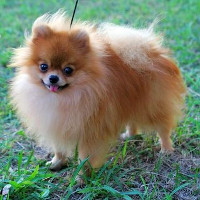Appearance of the Dameranian
|
| The Dameranian is a combination of the two parent breeds, the Dachshund and the Spitz Toy / Pomeranian. The Dachshund can have a smooth or wire-haired coat. The Smooth coat is short and glossy. Colors vary, some being solid, usually red or cream, with a few black hairs. There are two-tone Dachshunds, usually black, chocolate, boar (graying), gray or fawn with tan or cream markings. There are also spotted Dachshunds, which may have a merle pattern in their coat. Wirehaired Dachshunds have short, thick, hard hair as a topcoat with a soft undercoat. The same colors apply to Wirehaired and Smooth Dachshunds. There are also long-haired Dachshunds. Their coat is long and slightly wavy. The Spitz Toy / Pomeranian is considered a toy-sized dog. The Pom is available in many colors, including black, black and tan, blue and tan, chocolate and tan, cream, cream sable, orange, red, sable, brindle and white. At its heaviest, the Spitz Toy / Pomeranian normally weighs just 3 kilos. The Spitz Toy / Pomeranian has a long coat and short undercoat. Most often seen with a smooth coat, Dameranians can have floppy or erect ears. The eyes are usually Dachshund-shaped and colored. |
Temperament of the Dameranian
|
| A look at the parent breeds can give us an idea of the type of behavior to expect from the hybrid breed. The Dachshund is a lively, playful little dog. He's brave and bold, but can also be a little stubborn. They love to cuddle with their family, and remember that they may choose one member over another to form a special bond with. Sometimes, if they're too lonely, they'll display anxious behaviors. Wirehaired Dachshunds tend to be mischievous. Long-haired Dachshunds tend to be calm, and Smooth Dachshunds are a mixture of both. With good socialization, the Dachshund is a happy, affectionate little addition to your family. The Spitz Toy / Pomeranian is considered an extrovert dog who loves others and animals. However, he thinks he's much bigger than he really is and can sometimes challenge other dogs. He is alert and curious. He can be prone to barking, so training to stop barking on command should start at an early age. Most correctly socialized Spitz Toy / Pomeranian do not show the aggression mentioned above. This also helps with small children, as some Poms are not good with children if they are not properly socialized. Your Dameranian is likely to be a little bundle of fire, ready for action and bossing everyone around. Use positive reinforcement when training and you should be able to teach him how to behave. |
Needs and activities of the Dameranian
|
| The Dameranian is a fairly active dog. It's recommended that he gets enough exercise to ensure he doesn't put on weight. He may or may not be inclined to roam, depending on his parentage, but it would be wise to keep him on a leash unless you're in a fenced-in area. He'll enjoy short, brisk walks with you, as well as a visit to the dog park. He's usually able to get along with other dogs and pets if he's had the opportunity to rub shoulders with them on a regular basis. He can also enjoy playtime with the children in your family. |
Maintenance of the Dameranian
|
| The Dameranian will most likely have a fairly easy grooming routine, but it must be carried out consistently. Regardless of whether your hybrid ends up with a smooth or fluffy coat, long or short, you should brush it at least once a week. A matted coat can occur if the coat is long and silky. Loss is always visible, whatever the length of the coat. A pin brush will work in any coat texture and is an excellent brush for removing tangles. If your Dameranian has long ears, check them often for dirt and moisture build-up. Small dogs are notorious for teething problems and periodontal disease, so don't neglect the teeth. Brush them daily if possible. Nail care is essential, and twice-weekly clipping should suffice. |










 English (United Kingdom)
English (United Kingdom)